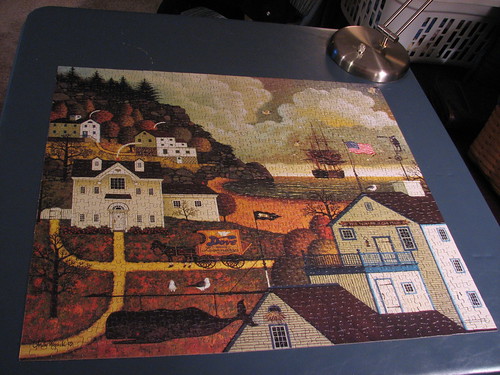Yesterday I wanted to make some soup from a stewing hen, so I started with my broth recipe.
1 gal. water
1 tbs vinegar
1 stewing hen
3 large onions, quartered
5 cloves garlic, smashed
4-6 tbs coconut oil
2-4 tbs celtic sea salt
1 tbs dried ginger flakes
1 16 oz. pkg. frozen broccoli cuts (or fresh)
Put water and vinegar in large stock pot, let sit 10 minutes. Add remaining ingredients. Bring to a boil, then simmer for 1.5 hours. Remove chicken from pot, remove meat from bones, return bones to pot. Simmer up to 24 hours. Close to eating time steam the broccoli; remove all the bones from the pot. Put several ladles full of broth into the blender (food processor probably would work also) along with one ladle of broccoli. Blend until almost smooth. Place in another large pot. Repeat this until the broccoli is gone. There will be broth leftover to refrigerate for another use. Cut up the chicken meat and put in the soup. Simmer until chicken is hot. I didn't do this because I just now thought about it, but you could add fresh ground pepper to it also or any other spice you'd like to add.
There you have it. I would guess it to make about 6-8 servings. It's a good dairy free alternative, because the blending makes it seem like a creamy soup. It's also got the calcium in it because of the bone broth.
The added vinegar helps take calcium and probably other minerals from the bones. One other thing that's recommended for making broth is to add a bunch of parsley to the stock pot for 10-30 minutes. I read it helps to remineralize it. Actually, the exact quote from Nourishing Traditions is, "This will impart additional mineral ions to the broth."
I which I share with my blogging friends my creations, my beliefs, my passions and a few of my frustrations.
Saturday, January 30, 2010
Thursday, January 28, 2010
Beautiful Blogger Award

I was nominated by Elizabeth for this award. You're so sweet. I just love my blogging friends.
The terms of accepting this are you must thank the person who nominated you, paste the award on your blog, link back to the nominator, tell 7 interesting things about myself and nominate 7 others linking to them.
Ok here goes. This is going to be difficult, I'm thinkin'.
1. As much as I love sewing now, I used to hate it when I was 14, just ask my mom. I assume she remembers. Since I started sewing as an adult I've had a rule: never sew at night. I learned this lesson the hard way as a teen. I was much too tired and stressed by some project that I was sewing. I don't remember what is was or even if I threw a fit, but I do know I was sewing at night. Hence the rule. I have broken it, but very rarely.
2. When I was working nights at the hospital, I occasionally worked with a nurse who would knit. It looked impossibly hard. I knew I'd never be able to do it, but I really wanted to learn and I really wanted to learn from someone, like a nice granny type. Almost 20 years later I found videos on the internet and DVDs at the library and taught myself how to knit. I taught myself so much (not that much) that I actually impressed an experienced knitter from church. We got together for her to teach me a few things I didn't understand and she said I knew quite a bit for a beginner. Now I can't knit very much because it hurts my finger, hand and elbow. :( I hope that's not permanent and I hope it's not "pride goes before a fall" because I love to knit.
3. Since I can't knit very often (just a few rows a week) I've taken up quilting. I've discovered that I love fabric shopping. I love to do it in person, but I also enjoy internet shopping. ;-) The shopping is the best part! I also like being able to give a quilt away. I've got several baby-sized quilt tops that need to be quilted to send with my friend to Russia.
4. One of my dreams is to live in Alaska for a year. I want to experience the light/dark thing and see the Northern Lights. Now I really doubt this will happen because I'm married to a guy who would rather live in Hawaii for a year. ;-) Winter is my favorite season. You just have to know how to dress for it and possibly be content with the indoors. Just give me a lot of snow, a good book, a sewing machine, a camera, a good movie, a puzzle and my family and I'm happy. I'm not asking for much. :)
5. In the last year or so I've learned a lot more about economics than I thought I'd even want to know. There are actually different schools of thought about econ. Take the Keynesians for example, my rudimentary understanding is that this philosophy is based on spending your way out of economic problems. The Austrian school of thought is primarily based on a free market and no government intervention. I just recently heard of the Chicago school of thought, but I have no idea what that is. I'll have to look into it.
6. By the grace of God I've been a Christian for 34 years. I still have plenty of things I struggle with like fear. I have 11 Bible verses taped to the wall above the computer reminding me of God's attributes. He is a refuge; He loves us; He guards; He provides peace; He provides our daily needs; He directs; He is strong; He calls; He saves; He made us; He gives. I need to trust and rest.
7. I do NOT like opera. Now I feel bad about this because it seems like something I should like. But I've thought about it for a while and have come to the conclusion that the reason has to do with sensory overload or whatever the correct term is. The soprano voice is especially grating. It's similar to how I feel about heavy metal. It's just too much.
Now for the seven people I'm tagging.
1. Christine at A Peek Inside Our Adventure because I'm sure she needs a break. :)
2. Hope Anne at Happymom4 because I'm sure she needs something else to do.
3. Karen at J Place because I'd like to read her blog more often. ;-)
4. Amy at Rose of Sharon because it's good for her to practice her creative writing.
5. Cheri at Southern Hills Ramblings because it's always good to get to know a blogging friend better.
6. Mom at Technically Challenged because I like how she writes.
7. Nancy at Brambleberry Cottage because I want to see how she's doing and she's a fellow seamstress for AG dolls. :)
Wednesday, January 27, 2010
Puzzle #53 and the mourning doves
Tuesday, January 26, 2010
On the Road to Spring quilt-along
Starting this week I'm participating in i have to say's quilt-along. It's a six week process. If you click on the quilt-along picture it'll take you to week one's instructions as well as the rest of the schedule.
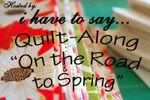
Here are my fabrics for the quilt-along.

They were all gathered from my stash. I did buy white Kona cotton to be my solid for this project and I'll probably have to get something for the back yet. I'm going to try to find something from my stash for the binding. I don't think it'll be a problem. ;-)

Here are my fabrics for the quilt-along.

They were all gathered from my stash. I did buy white Kona cotton to be my solid for this project and I'll probably have to get something for the back yet. I'm going to try to find something from my stash for the binding. I don't think it'll be a problem. ;-)
Thursday, January 21, 2010
Guess what I found!
Today I went quilt shop hopping. Seemed like a fun thing to do after finishing the quilting on the current quilt. I started at the shop farthest away and worked my way home. At the very first shop I went to some of the fabric looked familiar, so I decided to ask the clerk about it.
Back in October my local quilt shop closed abruptly. I got the email the day after they closed. I wondered what she did with all that fabric, where did it go?
The clerk's answer was, "Yes." My question: "Did you buy F.O.'s fabric?" Turns out that the owner of Quilt Garden went to F.O. to take a look at the fixtures. While she was there L.M. asked her if she wanted to buy everything (including all the fabric). Wow! She wasn't prepared for that question, so she went to lunch and did the math. Turns out she did buy it, all 575 bolts of fabric and the fixtures! She then asked L.M. when she was closing and L.M. said, "Right now." The owner of Quilt Garden picked up the goods on Monday, L.M. and her husband left to winter in FL on Friday. Can you imagine?
No wonder the fabric looked familiar. BTW I only bought a quarter of a yard of three fabrics for binding the current quilt. :)
Back in October my local quilt shop closed abruptly. I got the email the day after they closed. I wondered what she did with all that fabric, where did it go?
The clerk's answer was, "Yes." My question: "Did you buy F.O.'s fabric?" Turns out that the owner of Quilt Garden went to F.O. to take a look at the fixtures. While she was there L.M. asked her if she wanted to buy everything (including all the fabric). Wow! She wasn't prepared for that question, so she went to lunch and did the math. Turns out she did buy it, all 575 bolts of fabric and the fixtures! She then asked L.M. when she was closing and L.M. said, "Right now." The owner of Quilt Garden picked up the goods on Monday, L.M. and her husband left to winter in FL on Friday. Can you imagine?
No wonder the fabric looked familiar. BTW I only bought a quarter of a yard of three fabrics for binding the current quilt. :)
Wednesday, January 20, 2010
1st of three posts for the day :)
Quilting made easier
By putting Amy's adjustable sewing table lower than our kitchen table my sewing machine sits flush with the kitchen table. :)
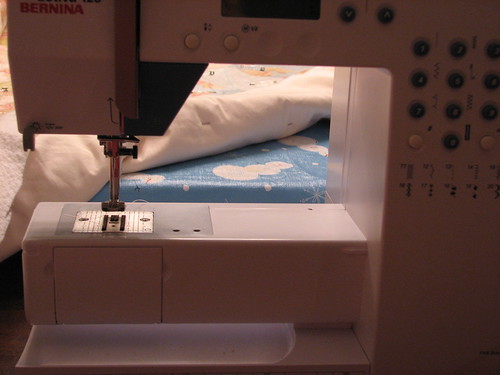
That means the quilt just glides nicely across the table with no dragging or getting stuck.
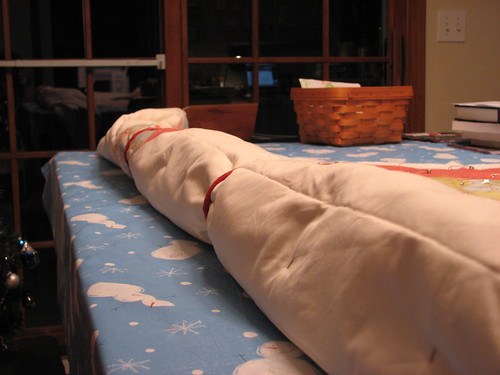
I'm absolutely amazed at how much easier the quilting went this time as opposed to last time.
Now be sure to scroll down the next two posts for the day. :)
By putting Amy's adjustable sewing table lower than our kitchen table my sewing machine sits flush with the kitchen table. :)

That means the quilt just glides nicely across the table with no dragging or getting stuck.

I'm absolutely amazed at how much easier the quilting went this time as opposed to last time.
Now be sure to scroll down the next two posts for the day. :)
Puzzles #51& 52
God's Rhapsody in Gray
God's Rhapsody in Gray
by Bojidar Marinov, Jan 20, 2010
These last weeks the British government was taught a lesson in common sense once again. In response to the rising costs of propane (natural gas in Britain), coal, and electricity, British pensioners resorted to buying books from charity stores to use as cheap fuel in the harsh winter. Fuel prices have remained stable around the world for the last two years but not in Britain. There, the prices went up by 20 to 40 percent for the same period, all due to the obsession of the British government to fight global warming through its excessive Climate Change Levy—a tax that is increased every year at a rate almost double the inflation rate. The government’s obsession with the myth of global warming made prices of coal too high for the poor and elderly in Britain, and now, as a result, instead of carbon from coal, Britain will emit carbon from burned books. Same carbon but processed and refined and enriched with ink and glue.
“Boo for the British government’s lack of common sense,” you would say. Well, we knew from Cyril Parkinson that the British government has long ago severed any connections between its decision-making process and plain common sense. There isn’t much hope that something will change for good, and therefore the news is disturbing and disappointing. But I have a better, fresher, and more optimistic perspective on this situation.
The pensioners’ actions are another example of what economists would call a “gray economy.” Gray economy—by the definitions of the economists—are those economic activities that 1) are not registered in the official government statistics, or 2) thwart government regulations, restrictions, and controls by finding alternative legal ways to supply the controlled or regulated goods or services. Unlike black markets, the gray economy is perfectly legal, and it feeds on the inability of the socialist governments to be what they claim they can be: omniscient and omnipresent. That’s exactly what happened in the above story: The government wants to control the emissions of carbon through taxing it, and the pensioners found a way to emit uncontrolled, unregulated—and therefore cheap—carbon.
But there is more to it. The economic analysis fails to record the moral war going on. Yes, every socialist government is in a state of perpetual war against its own citizens, and we need to understand the gray economy as an aspect of that war. The British government has its commitment to a religion—the religion of global warming alarmism; this religion identifies as enemies all human beings who burn carbon—i.e., all of us—and the British pensioners are among its enemies. The government predictably attacks what supports the life and well-being of the enemies, their fuel supplies, by raising taxes. The pensioners, even though they lack the power to oppose the state, have not lost their will to survive, and they fight back. The fight seems hopeless for them, and yet they do not just lie in their cold rooms to freeze to death. The same spirit that was, for instance, in the Jewish fighters in the Warsaw Ghetto Uprising of 1943, is in those pensioners: Fight one more day, find a way to survive one more day against the Nazis, against an oppressive government that has committed all its resources to destroy your life in the name of its evil ideology.
The American Vision on Facebook
This will of the little people, of the individual citizen, to survive against all odds is the greatest problem of the welfare state. Socialism is an ideology that calls for the confiscation of the individual’s life, liberty and property by the state; but whatever resources socialist governments commit to their propaganda, they can never talk the individual people out of loving their life, liberty, and property. Whatever laws and forces they commit to achieving the goal, they will always meet resistance that is stronger, smarter, and more resourceful than the best the government can muster. The little people don’t need an ideology to resist; it is in their blood to hold fast to what is rightfully theirs. Even in the most totalitarian regimes, government commissars and ideologists were not able to destroy the personal will to live and survive and resist immoral governments.
And the gray economy is by far the most formidable social expression of that will to resist. No socialist government has ever been able to destroy it. In Communist Eastern Europe before 1989 all private enterprise was outlawed. And yet, people kept having their little workshops and little plots of land in their backyards where they would produce useful little things or food and sell them to others. Authors would self-publish their books—samizdat—and distribute them outside of the official government channels. Many examples of such passive resistance can be cited, even in the Gulags, as related by Solzhenitsyn. So prevalent was it that in the early 1980s Andropov capitulated and allowed peasants to produce food on their own land and sell it and craftsmen to open their own shops and produce items and services for the market. In the nations of the European Union today billions of Euro circulate in activities that are not reported to the government statisticians. Even in the most prosperous and organized nation member of the EU, Finland, economists are complaining of the large share of the gray economy, and openly state that it is a “significant threat to the welfare state.”
The Revolutionary War that created the United States of America started over government control on private trade, and many of the heroes in the war were champions of the gray economy that defied controls and regulations. Two decades ago even the Chinese Communist government capitulated before the gray and allowed private property and enterprise, only to legalize and tax what has been going on in secret even during the worst times of Mao’s cultural revolution.
And eventually the envirofascist government of Great Britain will be forced to capitulate before the will of the people to survive, unless it decides to impose Fossil Fuel Tax on books. Pensioners might then turn to burn furniture, trash, or cow manure to keep warm.
The gray economy is indestructible, and this is not only because of the essential nature of man. God Himself is the Protector of the gray economy. He has established boundaries, a wall of separation between the civil government and the private economic transactions of the individuals, and the Biblical law mandates census only in time of war. King David himself, when he ordered Joab to number the people, incurred God’s wrath upon himself and upon the nation. God not only refused to support “official statistics” for government purposes, He in fact was angry at the very idea. Samuel in 1 Samuel 8 described an ungodly government in terms of government control over the economy and the labor force as well as control over “thousands and fifties.” In the book of Judges, the Angel of the Lord called Gideon to lead His army while Gideon was involved in “gray economy” activities of threshing wheat in the winepress, to hide it from the government tax-collectors of the Midianites. The Hebrew midwives deliberately lied to the Egyptian Ministry of Planned Parenthood; and the KGB of Jericho got a false report from Rahab. God blessed the midwives and Rahab for their courage to participate in the gray economy. Joseph decided to take his wife and her son and emigrate from Israel—a legal move per se, but it thwarted the environmentalist plans of Herod’s government of cleaning the world of undesirables.
America will not be an exception. With a government that is consistently moving towards more socialism, we will see more resources produced and exchanged in the gray economy. Government statisticians and economists already express concern over this phenomenon; one wonders why they are surprised. In fact, they should expect Americans to be even more willing to engage in it; first, because of the proud tradition on which America was founded, resistance to wicked governments, and second, because Americans more than any other nation in the world have the will to resist and survive. Because of the greater opportunities and traditions here, the gray economy will be much more diverse and resourceful—private money, informal banking and leasing, community services, barter bargains for goods and services, church related activities of mutual aid, healthcare, and charity services; legal, financial, and other counseling; and of course, that new nemesis for all government control freaks: Internet-based services and trade. Compared to what America and Americans can produce in the field of economic activity under the radar of the official statistics, Europe’s gray economy will look like an amateurish play.
People often ask me, in the face of so much evidence for America’s free fall into socialism and tyranny, why I am so optimistic about the future of this nation. I answer: I saw Communism fall. It was big, ugly, it had all the resources, it had all the guns and it had all the food, and it could kill and spare at will, and . . . it fell. It didn’t fall before mighty military conquerors; it fell before the gray little people whose will to survive it couldn’t break. It capitulated before their ingenuity to find ways to produce and trade under all the government restrictions and controls.
That’s why the news from England are exciting and optimistic. Where people haven’t lost their will to live, where the gray economy still survives and functions in all its multiple diversity, there tyrants are still fighting an uphill battle. May God bless us to understand this and act on it.
by Bojidar Marinov, Jan 20, 2010
These last weeks the British government was taught a lesson in common sense once again. In response to the rising costs of propane (natural gas in Britain), coal, and electricity, British pensioners resorted to buying books from charity stores to use as cheap fuel in the harsh winter. Fuel prices have remained stable around the world for the last two years but not in Britain. There, the prices went up by 20 to 40 percent for the same period, all due to the obsession of the British government to fight global warming through its excessive Climate Change Levy—a tax that is increased every year at a rate almost double the inflation rate. The government’s obsession with the myth of global warming made prices of coal too high for the poor and elderly in Britain, and now, as a result, instead of carbon from coal, Britain will emit carbon from burned books. Same carbon but processed and refined and enriched with ink and glue.
“Boo for the British government’s lack of common sense,” you would say. Well, we knew from Cyril Parkinson that the British government has long ago severed any connections between its decision-making process and plain common sense. There isn’t much hope that something will change for good, and therefore the news is disturbing and disappointing. But I have a better, fresher, and more optimistic perspective on this situation.
The pensioners’ actions are another example of what economists would call a “gray economy.” Gray economy—by the definitions of the economists—are those economic activities that 1) are not registered in the official government statistics, or 2) thwart government regulations, restrictions, and controls by finding alternative legal ways to supply the controlled or regulated goods or services. Unlike black markets, the gray economy is perfectly legal, and it feeds on the inability of the socialist governments to be what they claim they can be: omniscient and omnipresent. That’s exactly what happened in the above story: The government wants to control the emissions of carbon through taxing it, and the pensioners found a way to emit uncontrolled, unregulated—and therefore cheap—carbon.
But there is more to it. The economic analysis fails to record the moral war going on. Yes, every socialist government is in a state of perpetual war against its own citizens, and we need to understand the gray economy as an aspect of that war. The British government has its commitment to a religion—the religion of global warming alarmism; this religion identifies as enemies all human beings who burn carbon—i.e., all of us—and the British pensioners are among its enemies. The government predictably attacks what supports the life and well-being of the enemies, their fuel supplies, by raising taxes. The pensioners, even though they lack the power to oppose the state, have not lost their will to survive, and they fight back. The fight seems hopeless for them, and yet they do not just lie in their cold rooms to freeze to death. The same spirit that was, for instance, in the Jewish fighters in the Warsaw Ghetto Uprising of 1943, is in those pensioners: Fight one more day, find a way to survive one more day against the Nazis, against an oppressive government that has committed all its resources to destroy your life in the name of its evil ideology.
The American Vision on Facebook
This will of the little people, of the individual citizen, to survive against all odds is the greatest problem of the welfare state. Socialism is an ideology that calls for the confiscation of the individual’s life, liberty and property by the state; but whatever resources socialist governments commit to their propaganda, they can never talk the individual people out of loving their life, liberty, and property. Whatever laws and forces they commit to achieving the goal, they will always meet resistance that is stronger, smarter, and more resourceful than the best the government can muster. The little people don’t need an ideology to resist; it is in their blood to hold fast to what is rightfully theirs. Even in the most totalitarian regimes, government commissars and ideologists were not able to destroy the personal will to live and survive and resist immoral governments.
And the gray economy is by far the most formidable social expression of that will to resist. No socialist government has ever been able to destroy it. In Communist Eastern Europe before 1989 all private enterprise was outlawed. And yet, people kept having their little workshops and little plots of land in their backyards where they would produce useful little things or food and sell them to others. Authors would self-publish their books—samizdat—and distribute them outside of the official government channels. Many examples of such passive resistance can be cited, even in the Gulags, as related by Solzhenitsyn. So prevalent was it that in the early 1980s Andropov capitulated and allowed peasants to produce food on their own land and sell it and craftsmen to open their own shops and produce items and services for the market. In the nations of the European Union today billions of Euro circulate in activities that are not reported to the government statisticians. Even in the most prosperous and organized nation member of the EU, Finland, economists are complaining of the large share of the gray economy, and openly state that it is a “significant threat to the welfare state.”
The Revolutionary War that created the United States of America started over government control on private trade, and many of the heroes in the war were champions of the gray economy that defied controls and regulations. Two decades ago even the Chinese Communist government capitulated before the gray and allowed private property and enterprise, only to legalize and tax what has been going on in secret even during the worst times of Mao’s cultural revolution.
And eventually the envirofascist government of Great Britain will be forced to capitulate before the will of the people to survive, unless it decides to impose Fossil Fuel Tax on books. Pensioners might then turn to burn furniture, trash, or cow manure to keep warm.
The gray economy is indestructible, and this is not only because of the essential nature of man. God Himself is the Protector of the gray economy. He has established boundaries, a wall of separation between the civil government and the private economic transactions of the individuals, and the Biblical law mandates census only in time of war. King David himself, when he ordered Joab to number the people, incurred God’s wrath upon himself and upon the nation. God not only refused to support “official statistics” for government purposes, He in fact was angry at the very idea. Samuel in 1 Samuel 8 described an ungodly government in terms of government control over the economy and the labor force as well as control over “thousands and fifties.” In the book of Judges, the Angel of the Lord called Gideon to lead His army while Gideon was involved in “gray economy” activities of threshing wheat in the winepress, to hide it from the government tax-collectors of the Midianites. The Hebrew midwives deliberately lied to the Egyptian Ministry of Planned Parenthood; and the KGB of Jericho got a false report from Rahab. God blessed the midwives and Rahab for their courage to participate in the gray economy. Joseph decided to take his wife and her son and emigrate from Israel—a legal move per se, but it thwarted the environmentalist plans of Herod’s government of cleaning the world of undesirables.
America will not be an exception. With a government that is consistently moving towards more socialism, we will see more resources produced and exchanged in the gray economy. Government statisticians and economists already express concern over this phenomenon; one wonders why they are surprised. In fact, they should expect Americans to be even more willing to engage in it; first, because of the proud tradition on which America was founded, resistance to wicked governments, and second, because Americans more than any other nation in the world have the will to resist and survive. Because of the greater opportunities and traditions here, the gray economy will be much more diverse and resourceful—private money, informal banking and leasing, community services, barter bargains for goods and services, church related activities of mutual aid, healthcare, and charity services; legal, financial, and other counseling; and of course, that new nemesis for all government control freaks: Internet-based services and trade. Compared to what America and Americans can produce in the field of economic activity under the radar of the official statistics, Europe’s gray economy will look like an amateurish play.
People often ask me, in the face of so much evidence for America’s free fall into socialism and tyranny, why I am so optimistic about the future of this nation. I answer: I saw Communism fall. It was big, ugly, it had all the resources, it had all the guns and it had all the food, and it could kill and spare at will, and . . . it fell. It didn’t fall before mighty military conquerors; it fell before the gray little people whose will to survive it couldn’t break. It capitulated before their ingenuity to find ways to produce and trade under all the government restrictions and controls.
That’s why the news from England are exciting and optimistic. Where people haven’t lost their will to live, where the gray economy still survives and functions in all its multiple diversity, there tyrants are still fighting an uphill battle. May God bless us to understand this and act on it.
Saturday, January 16, 2010
Raw Milk and the Sour State
Control of the Milk Supply is a Primary Step toward Government Control of the Larger Food Supply
By William E. Pike • January/February 2009 • Volume: 59 • Issue: 1
Raw Milk and the Sour State
Take a moment, if you will, to think about the milk you buy from the grocery store. Whether it is an expensive organic brand or simply carries a mega-chain store name, that milk has undergone pasteurization and homogenization. In pasteurization it has been quickly heated to temperatures up to 250 degrees Fahrenheit for a few seconds to kill bacteria. In homogenization the milk has passed through a tiny valve at pressures exceeding 20,000 pounds per square inch, breaking up fat globules so that cream does not rise to the top. In addition to these volatile treatments, your milk may come from cows fed specially designed hormones to help the animals produce at a rate far beyond that which nature intended.
There is a growing subset of consumers who would prefer not to buy their milk this way. They want it unpasteurized, unhomogenized—in a word, “raw.” They would prefer to drink their milk as humans have consumed it for centuries, which is also how every single signer of the U.S. Constitution drank it.
To procure such a basic product, however, these consumers—with some exceptions—are forced to break the law. The basic retail sale of raw milk for human consumption is legal in only eight states—Arizona, California, Connecticut, Maine, Pennsylvania, South Carolina, New Mexico, and Washington. Its sale for human consumption across state lines is illegal nationwide. In some other states raw milk can be sold at the farm site only, sold through “cow share” programs, or legally marketed as “pet food.” Seventeen states completely forbid the sale of raw milk in any way.
How did this happen? We all learned in childhood about Louis Pasteur’s development of pasteurization in the mid-1800s. For mass-produced milk in an age before refrigeration, pasteurization was indeed a godsend. Early in the twentieth century, as people died at alarming rates due to contaminated milk from filthy urban dairy centers, pasteurization caught on as a hot market trend. In a time when milk collection and storage on large-scale farms was unsanitary and unrefrigerated (and when additives as diverse as marigold petals and animal brains were placed in milk to add body), pasteurization helped save lives. Thus people were willing to pay for it. But then one city after another began to mandate the process through legislation. In 1948 Michigan became the first state to ban the sale of unpasteurized milk, and other states soon followed suit. In 1986 a federal judge ordered that interstate shipments of raw milk be banned, further limiting supply for consumers.
Now, despite advances in dairy-production techniques, it doesn’t matter how clean the equipment or how healthy the cow; raw milk is either illegal or highly suspect, and state and federal bureaucracies see it as a threat to the population. Regulation overstepped the free market and did an end run around common sense.
Raw-milk advocates argue that milk in its pure state is quite beneficial to health. According to the Weston A. Price Foundation, a leading natural-foods organization, raw milk reduces the incidence of asthma, eczema, and hay fever in children. Unpasteurized milk also aids the body’s natural digestive system. Pasteurization, the Foundation insists, kills helpful bacteria and breaks down delicate proteins in milk, leading to the dairy intolerance seen in so many individuals in this modern age. Advocates also state that unpasteurized milk strengthens the immune system and provides optimal growth and development for young people.
The opinion of government officials, backed up by the bulk of the medical community, is that every bit of that is hogwash. A joint press release from the U.S. Food and Drug Administration and the Centers for Disease Control, dated March 1, 2007, reminds consumers “of the dangers of drinking milk that has not been pasteurized.” Among the litany of diseases said to be carried by raw milk are “listeriosis, salmonellosis, campylobacteriosis, typhoid fever, tuberculosis, diphtheria and brucellosis.” It is enough to make one wonder how Amish communities manage to survive.
The FDA/CDC claims that “There is no meaningful nutritional difference between pasteurized and raw milk.” The Price Foundation retorts that no research is cited by the FDA/CDC to substantiate such claims. The press release also states that “From 1998 to May 2005 CDC identified 45 outbreaks of foodborne illnesses,” accounting for “1,007 illnesses, 107 hospitalizations, and two deaths.” Aside from the fact that these are minuscule numbers for a population of nearly 300 million being tracked over seven years, there seems to be little evidence to back up the figures. Thomas Bartlett, in an article on raw milk (“The Raw Deal,” October 1, 2006), went looking for such cases of illness. In addition to finding no anecdotal evidence whatsoever, he also asked John Sheehan, then-director of the FDA’s dairy and egg safety division, for evidence linking raw milk to deadly disease outbreaks.
Sheehan admitted that he didn’t know of any such cases in the United States in the past 20 years. Nevertheless, the official line on raw milk is so ingrained as to be farcical. In interviewing a Maryland state health official about raw milk sales, Bartlett was told selling raw milk was as bad as selling marijuana, and the official compared such producers to heroin dealers.
Indeed, the question is far more important than, “Is raw milk beneficial?” or even, “Is raw milk safe?” It is this: What right does the state have to outlaw the sale of unpasteurized milk in the first place?
Imagine the case of Mark Nolt of New Line, Pennsylvania. Nolt was arrested—arrested—last May in a sting operation in which undercover officials purchased raw milk from his farm. Nolt, a Mennonite farmer with ten children, was fined $4,040, had his equipment and products seized, and was threatened with jail if he tried to sell raw milk again. His case is not unique. Nolt’s spokesman at his trial, Jonas Stoltzfus, eloquently summed up the situation: “This issue has very little to do with raw milk and health, and everything to do with freedom.”
Controlling the Milk Supply
But why milk? Indeed, as the 2008 pepper scare has proven, harmful bacteria can find their way to many other food sources. However, milk is different from most other food products. It is a staple among staples. To control the milk supply is to control the food supply.
Pasteurization is not a cheap process, and therefore the legal demand for pasteurization favors large producers. A small, independent dairy farm may very well not be able to afford pasteurization equipment (not at government standards, at least), and thus micro-dairies can rarely operate legally on their own. With the dairy industry more centralized, it becomes easier to track and regulate—and control.
Control of the milk supply has been a primary step in the state’s efforts to control the larger food supply. Agriculture continues to fall further and further under the eye of government regulation, as do businesses as diverse as potato-chip manufacturers and fast-food restaurants. The USDA, FDA, and myriad other state and federal agencies make no bones about their goal of controlling every morsel Americans consume—all for our own good, of course.
And where better to start than with milk? Think of the psychological benefits for the state emanating from such regulation. If a product as central and wholesome as milk can only be safe through government control, reliance on the paternalistic state grows. Has it worked? Ask a random acquaintance if he would consider drinking unpasteurized milk. You may very well get a look of horror in return. Why do people feel that way? Simply because they have been indoctrinated to feel that way. Why not be just as accepting of government regulation over their mayonnaise or their chicken or their lettuce? How about their water supply or the cars they drive or how warm they keep their homes in the wintertime? Though not necessarily a conscious progression, control by the state, when left unchecked, simply grows and expands naturally.
As ingrained in our social conscience as pasteurization has become, it is hard for many to step back and realize just how preposterous milk laws happen to be. One must ask if the many citizen-farmers who valiantly fought for liberty two centuries ago could have ever envisioned a “free” state in which one citizen would be legally barred from selling milk from his cow to another citizen. Even King George III would have laughed at that idea.
Control of the Milk Supply is a Primary Step toward Government Control of the Larger Food Supply
By William E. Pike • January/February 2009 • Volume: 59 • Issue: 1
Raw Milk and the Sour State
Take a moment, if you will, to think about the milk you buy from the grocery store. Whether it is an expensive organic brand or simply carries a mega-chain store name, that milk has undergone pasteurization and homogenization. In pasteurization it has been quickly heated to temperatures up to 250 degrees Fahrenheit for a few seconds to kill bacteria. In homogenization the milk has passed through a tiny valve at pressures exceeding 20,000 pounds per square inch, breaking up fat globules so that cream does not rise to the top. In addition to these volatile treatments, your milk may come from cows fed specially designed hormones to help the animals produce at a rate far beyond that which nature intended.
There is a growing subset of consumers who would prefer not to buy their milk this way. They want it unpasteurized, unhomogenized—in a word, “raw.” They would prefer to drink their milk as humans have consumed it for centuries, which is also how every single signer of the U.S. Constitution drank it.
To procure such a basic product, however, these consumers—with some exceptions—are forced to break the law. The basic retail sale of raw milk for human consumption is legal in only eight states—Arizona, California, Connecticut, Maine, Pennsylvania, South Carolina, New Mexico, and Washington. Its sale for human consumption across state lines is illegal nationwide. In some other states raw milk can be sold at the farm site only, sold through “cow share” programs, or legally marketed as “pet food.” Seventeen states completely forbid the sale of raw milk in any way.
How did this happen? We all learned in childhood about Louis Pasteur’s development of pasteurization in the mid-1800s. For mass-produced milk in an age before refrigeration, pasteurization was indeed a godsend. Early in the twentieth century, as people died at alarming rates due to contaminated milk from filthy urban dairy centers, pasteurization caught on as a hot market trend. In a time when milk collection and storage on large-scale farms was unsanitary and unrefrigerated (and when additives as diverse as marigold petals and animal brains were placed in milk to add body), pasteurization helped save lives. Thus people were willing to pay for it. But then one city after another began to mandate the process through legislation. In 1948 Michigan became the first state to ban the sale of unpasteurized milk, and other states soon followed suit. In 1986 a federal judge ordered that interstate shipments of raw milk be banned, further limiting supply for consumers.
Now, despite advances in dairy-production techniques, it doesn’t matter how clean the equipment or how healthy the cow; raw milk is either illegal or highly suspect, and state and federal bureaucracies see it as a threat to the population. Regulation overstepped the free market and did an end run around common sense.
Raw-milk advocates argue that milk in its pure state is quite beneficial to health. According to the Weston A. Price Foundation, a leading natural-foods organization, raw milk reduces the incidence of asthma, eczema, and hay fever in children. Unpasteurized milk also aids the body’s natural digestive system. Pasteurization, the Foundation insists, kills helpful bacteria and breaks down delicate proteins in milk, leading to the dairy intolerance seen in so many individuals in this modern age. Advocates also state that unpasteurized milk strengthens the immune system and provides optimal growth and development for young people.
The opinion of government officials, backed up by the bulk of the medical community, is that every bit of that is hogwash. A joint press release from the U.S. Food and Drug Administration and the Centers for Disease Control, dated March 1, 2007, reminds consumers “of the dangers of drinking milk that has not been pasteurized.” Among the litany of diseases said to be carried by raw milk are “listeriosis, salmonellosis, campylobacteriosis, typhoid fever, tuberculosis, diphtheria and brucellosis.” It is enough to make one wonder how Amish communities manage to survive.
The FDA/CDC claims that “There is no meaningful nutritional difference between pasteurized and raw milk.” The Price Foundation retorts that no research is cited by the FDA/CDC to substantiate such claims. The press release also states that “From 1998 to May 2005 CDC identified 45 outbreaks of foodborne illnesses,” accounting for “1,007 illnesses, 107 hospitalizations, and two deaths.” Aside from the fact that these are minuscule numbers for a population of nearly 300 million being tracked over seven years, there seems to be little evidence to back up the figures. Thomas Bartlett, in an article on raw milk (“The Raw Deal,” October 1, 2006), went looking for such cases of illness. In addition to finding no anecdotal evidence whatsoever, he also asked John Sheehan, then-director of the FDA’s dairy and egg safety division, for evidence linking raw milk to deadly disease outbreaks.
Sheehan admitted that he didn’t know of any such cases in the United States in the past 20 years. Nevertheless, the official line on raw milk is so ingrained as to be farcical. In interviewing a Maryland state health official about raw milk sales, Bartlett was told selling raw milk was as bad as selling marijuana, and the official compared such producers to heroin dealers.
Indeed, the question is far more important than, “Is raw milk beneficial?” or even, “Is raw milk safe?” It is this: What right does the state have to outlaw the sale of unpasteurized milk in the first place?
Imagine the case of Mark Nolt of New Line, Pennsylvania. Nolt was arrested—arrested—last May in a sting operation in which undercover officials purchased raw milk from his farm. Nolt, a Mennonite farmer with ten children, was fined $4,040, had his equipment and products seized, and was threatened with jail if he tried to sell raw milk again. His case is not unique. Nolt’s spokesman at his trial, Jonas Stoltzfus, eloquently summed up the situation: “This issue has very little to do with raw milk and health, and everything to do with freedom.”
Controlling the Milk Supply
But why milk? Indeed, as the 2008 pepper scare has proven, harmful bacteria can find their way to many other food sources. However, milk is different from most other food products. It is a staple among staples. To control the milk supply is to control the food supply.
Pasteurization is not a cheap process, and therefore the legal demand for pasteurization favors large producers. A small, independent dairy farm may very well not be able to afford pasteurization equipment (not at government standards, at least), and thus micro-dairies can rarely operate legally on their own. With the dairy industry more centralized, it becomes easier to track and regulate—and control.
Control of the milk supply has been a primary step in the state’s efforts to control the larger food supply. Agriculture continues to fall further and further under the eye of government regulation, as do businesses as diverse as potato-chip manufacturers and fast-food restaurants. The USDA, FDA, and myriad other state and federal agencies make no bones about their goal of controlling every morsel Americans consume—all for our own good, of course.
And where better to start than with milk? Think of the psychological benefits for the state emanating from such regulation. If a product as central and wholesome as milk can only be safe through government control, reliance on the paternalistic state grows. Has it worked? Ask a random acquaintance if he would consider drinking unpasteurized milk. You may very well get a look of horror in return. Why do people feel that way? Simply because they have been indoctrinated to feel that way. Why not be just as accepting of government regulation over their mayonnaise or their chicken or their lettuce? How about their water supply or the cars they drive or how warm they keep their homes in the wintertime? Though not necessarily a conscious progression, control by the state, when left unchecked, simply grows and expands naturally.
As ingrained in our social conscience as pasteurization has become, it is hard for many to step back and realize just how preposterous milk laws happen to be. One must ask if the many citizen-farmers who valiantly fought for liberty two centuries ago could have ever envisioned a “free” state in which one citizen would be legally barred from selling milk from his cow to another citizen. Even King George III would have laughed at that idea.
Saturday, January 9, 2010
Puzzle #50
I did 46 puzzles in 2009, three in 2008. The first puzzle of 2010 is #50! It was also special because I had help from friends.
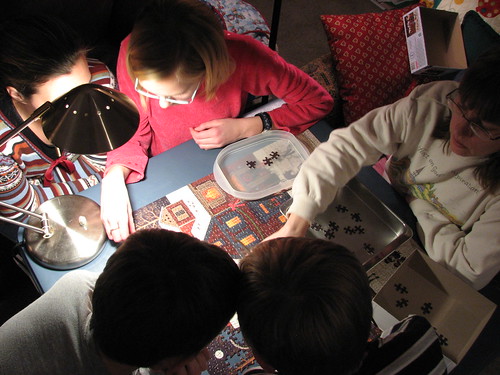
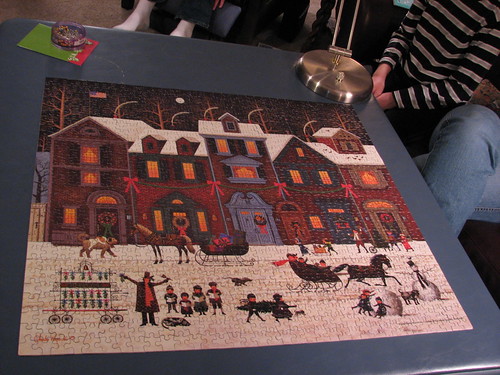
My helpful friends spent their last night in Ohio with us. They're on their way to FL in the next part of their life's journey. We knew them from when we lived in WI and about four years ago discovered we were all in OH. We got together regularly to visit, to go to Trader Joes, to do lunch, go to plays and to shop for quilting fabric. Our kids enjoyed playing together. We even discussed how the dynamics totally changed when they saw each other. I think their children are normally calm and relatively quiet (could have this wrong) as is Amy, but you get them in one place and all of a sudden there's noise and lots of it. Usually happy sounds. We will miss them and I would absolutely love to head to FL to visit, probably in the middle of winter some year. ;-)


My helpful friends spent their last night in Ohio with us. They're on their way to FL in the next part of their life's journey. We knew them from when we lived in WI and about four years ago discovered we were all in OH. We got together regularly to visit, to go to Trader Joes, to do lunch, go to plays and to shop for quilting fabric. Our kids enjoyed playing together. We even discussed how the dynamics totally changed when they saw each other. I think their children are normally calm and relatively quiet (could have this wrong) as is Amy, but you get them in one place and all of a sudden there's noise and lots of it. Usually happy sounds. We will miss them and I would absolutely love to head to FL to visit, probably in the middle of winter some year. ;-)
Tuesday, January 5, 2010
Saturated fat is good for you
Get Saturated: Four Reasons Saturated Fat is Healthy
(NaturalNews) Today we are caught between two philosophies: one says saturated fat is killing us; the other says these fats are necessary for true vitality. There is a heated back-and-forth, a constant tug-of-war scenario, with society caught in the middle like a child caught between two parents in a nasty divorce.
But fortunately, we are adults who can take a step back from the madness and look at the facts - all of the facts - before coming to our own conclusions. The trouble is finding anything but propaganda regarding saturated fats. Corporate food industry and government agencies are quick to demonize these fats, but in traditional cultures saturated fat was revered and even coveted as a source of vital energy.
Mankind has survived for century upon century thanks to saturated fats, depending on these fats to nourish our bodies and support the health of future generations. Only in recent decades have we turned away from natural fats and toward manufactured vegetable oils. And only in recent decades have we seen an explosion of degenerative conditions such as heart disease, diabetes and cancer. Here are four important reasons saturated fat should have its place at the table:
#1 - Lower Your Risk for Heart Disease and Improve Your Cholesterol Profile
It's the opposite of what the medical industry tells you, but it's true: eating a diet rich in saturated fats protects your heart. Saturated fat reduces Lp(a), which is associated with increased risk for heart disease, and contributes to higher levels of HDL (good) cholesterol, which keeps your heart healthy.
#2 - Prevent Loss of Bone Density and Osteoporosis
We all know we need calcium for strong, healthy bones. We also need saturated fat to transport that calcium to our bones. This is why dairy products naturally contain both calcium and saturated fat. All those calcium supplements won't do much good if saturated fat is lacking in our diet.
#3 - Strengthen Your Immunity and Prevent Illness
Saturated fats contain specialized fatty acids which are naturally antifungal, antimicrobial and antiviral. These important fatty acids include lauric acid, myristic acid and caprylic acid. A diet rich in these beneficial fats provides the body with what it needs to fight pathogenic substances.
#4 - Feed Your Brain, Your Nervous System and Your Hormones
Your brain is fat. And that's a good thing. Your brain consists mainly of fat and cholesterol, and it needs saturated fat more than any other kind. Even the brain-friendly omega-3 fatty acids can't be utilized without ample saturated fat. In addition, saturated fat facilitates nerve signals and hormone production. All of these systems rely on saturated fat to function, and to keep you healthy and ultimately alive.
It's important to choose the right saturated fats, like real butter and virgin coconut oil. Avoid highly processed fats and especially hydrogenated oils, which have been proven to cause heart disease, cancer and a slew of other conditions.
The logic is hard to miss. We are told saturated fats cause heart disease, so we trade butter for vegetable oils: heart disease skyrockets. We are told saturated fats cause bone to lessen, so we drink low-fat milk: osteoporosis is widespread. We are told saturated fat isn't good for our brains, so we stop eating traditional fats like coconut oil: depression, ADHD, dementia and autism are more prevalent than ever before. Are saturated fats really the villain here? In reality they are the victims of misinterpreted studies and commercialized industry, which have no interest in what our ancestors could have told them: saturated fat is the key to good health.
For More Information:
http://www.westonaprice.org/Know-Yo...
http://www.naturalnews.com/026819_l...
http://articles.mercola.com/sites/a...
About the author
Elizabeth Walling is a freelance writer, specializing in articles about health and family nutrition. She is a strong believer in natural living as a way to improve health and prevent common illnesses. To learn more about nourishing foods, stop by Elizabeth's blog, which explores topics like traditional nutrient-dense foods, lacto-fermentation, cod liver oil, raw and cultured dairy, soaking grains, and much, much more. http://thenourishedlife.blogspot.com/
(NaturalNews) Today we are caught between two philosophies: one says saturated fat is killing us; the other says these fats are necessary for true vitality. There is a heated back-and-forth, a constant tug-of-war scenario, with society caught in the middle like a child caught between two parents in a nasty divorce.
But fortunately, we are adults who can take a step back from the madness and look at the facts - all of the facts - before coming to our own conclusions. The trouble is finding anything but propaganda regarding saturated fats. Corporate food industry and government agencies are quick to demonize these fats, but in traditional cultures saturated fat was revered and even coveted as a source of vital energy.
Mankind has survived for century upon century thanks to saturated fats, depending on these fats to nourish our bodies and support the health of future generations. Only in recent decades have we turned away from natural fats and toward manufactured vegetable oils. And only in recent decades have we seen an explosion of degenerative conditions such as heart disease, diabetes and cancer. Here are four important reasons saturated fat should have its place at the table:
#1 - Lower Your Risk for Heart Disease and Improve Your Cholesterol Profile
It's the opposite of what the medical industry tells you, but it's true: eating a diet rich in saturated fats protects your heart. Saturated fat reduces Lp(a), which is associated with increased risk for heart disease, and contributes to higher levels of HDL (good) cholesterol, which keeps your heart healthy.
#2 - Prevent Loss of Bone Density and Osteoporosis
We all know we need calcium for strong, healthy bones. We also need saturated fat to transport that calcium to our bones. This is why dairy products naturally contain both calcium and saturated fat. All those calcium supplements won't do much good if saturated fat is lacking in our diet.
#3 - Strengthen Your Immunity and Prevent Illness
Saturated fats contain specialized fatty acids which are naturally antifungal, antimicrobial and antiviral. These important fatty acids include lauric acid, myristic acid and caprylic acid. A diet rich in these beneficial fats provides the body with what it needs to fight pathogenic substances.
#4 - Feed Your Brain, Your Nervous System and Your Hormones
Your brain is fat. And that's a good thing. Your brain consists mainly of fat and cholesterol, and it needs saturated fat more than any other kind. Even the brain-friendly omega-3 fatty acids can't be utilized without ample saturated fat. In addition, saturated fat facilitates nerve signals and hormone production. All of these systems rely on saturated fat to function, and to keep you healthy and ultimately alive.
It's important to choose the right saturated fats, like real butter and virgin coconut oil. Avoid highly processed fats and especially hydrogenated oils, which have been proven to cause heart disease, cancer and a slew of other conditions.
The logic is hard to miss. We are told saturated fats cause heart disease, so we trade butter for vegetable oils: heart disease skyrockets. We are told saturated fats cause bone to lessen, so we drink low-fat milk: osteoporosis is widespread. We are told saturated fat isn't good for our brains, so we stop eating traditional fats like coconut oil: depression, ADHD, dementia and autism are more prevalent than ever before. Are saturated fats really the villain here? In reality they are the victims of misinterpreted studies and commercialized industry, which have no interest in what our ancestors could have told them: saturated fat is the key to good health.
For More Information:
http://www.westonaprice.org/Know-Yo...
http://www.naturalnews.com/026819_l...
http://articles.mercola.com/sites/a...
About the author
Elizabeth Walling is a freelance writer, specializing in articles about health and family nutrition. She is a strong believer in natural living as a way to improve health and prevent common illnesses. To learn more about nourishing foods, stop by Elizabeth's blog, which explores topics like traditional nutrient-dense foods, lacto-fermentation, cod liver oil, raw and cultured dairy, soaking grains, and much, much more. http://thenourishedlife.blogspot.com/
Monday, January 4, 2010
Two recipes
Here a two recipes I've tried recently(without pictures because I don't think about taking pictures of food until after it's gone or put in the frig.).
Provencal Garlic Soup
4 heads garlic
1 large yellow onion, chopped
42 oz. chicken broth
1 - 6 oz. can tomato paste
3 tbs. olive oil
1. Fill small deep saucepan with water, bring to a boil. Separate garlic into cloves, place in water; blanch exactly one minute. Drain in colander, rinse under cold water. Peel.
2. Combine garlic, onion, broth & tomato paste in a slow cooker, stir. Cover, cook on low 6 to 7 hours.
3. Puree the soup with hand held blender, food processor or regular blender. Before serving add the olive oil. Ladle into bowls.
This one is yummy. It's got a slightly sweet tangy flavor. I think it could use a little salt, but it's fine without. Step one is pretty time consuming. My family did like it.
Fancy Fixins Cauliflower
1 small head cauliflower
1 tbs butter
1 stalk celery, thinly sliced
2 tbs cider vinegar
2 tbs chicken broth or water
1 tbs canned pimientos, drained, chopped
1 tsp sugar (I substituted a dash of stevia)
1/4 tsp dried thyme
1/8 tsp black pepper
1. Separate cauliflower into florets. In large saucepan, bring 1/2 inch water to boil. Add cauliflower. Lower heat, simmer, covered 8 - 10 minutes. Drain. Transfer to serving bowl.
2. Meanwhile, in small saucepan, heat butter over medium heat. Add celery, cook 5 minutes or until tender. Stir in vinegar and remaining ingredients. Drizzle over cauliflower. Stir and serve.
This recipe was pretty easy to do. Dh liked it, Amy didn't care for the vinegar flavor.
Provencal Garlic Soup
4 heads garlic
1 large yellow onion, chopped
42 oz. chicken broth
1 - 6 oz. can tomato paste
3 tbs. olive oil
1. Fill small deep saucepan with water, bring to a boil. Separate garlic into cloves, place in water; blanch exactly one minute. Drain in colander, rinse under cold water. Peel.
2. Combine garlic, onion, broth & tomato paste in a slow cooker, stir. Cover, cook on low 6 to 7 hours.
3. Puree the soup with hand held blender, food processor or regular blender. Before serving add the olive oil. Ladle into bowls.
This one is yummy. It's got a slightly sweet tangy flavor. I think it could use a little salt, but it's fine without. Step one is pretty time consuming. My family did like it.
Fancy Fixins Cauliflower
1 small head cauliflower
1 tbs butter
1 stalk celery, thinly sliced
2 tbs cider vinegar
2 tbs chicken broth or water
1 tbs canned pimientos, drained, chopped
1 tsp sugar (I substituted a dash of stevia)
1/4 tsp dried thyme
1/8 tsp black pepper
1. Separate cauliflower into florets. In large saucepan, bring 1/2 inch water to boil. Add cauliflower. Lower heat, simmer, covered 8 - 10 minutes. Drain. Transfer to serving bowl.
2. Meanwhile, in small saucepan, heat butter over medium heat. Add celery, cook 5 minutes or until tender. Stir in vinegar and remaining ingredients. Drizzle over cauliflower. Stir and serve.
This recipe was pretty easy to do. Dh liked it, Amy didn't care for the vinegar flavor.
Sunday, January 3, 2010
Goals for 2010
Here are last year's goals:
*The first one is to read the whole Bible this year using Tabletalk's plan.
*The other one is to cook through the pile of recipes I have copied from on-line.
I am happy that I accomplished the first one. I'm amazed at how wrong my attitude was be about Bible reading. At times, it would seem like such a drudgery to read three or four chapters in a day. Sometimes it take a whole 20 minutes! Gasp. Then I would turn around and easily read that many chapters of some fiction or spend way more time than that on the computer. In that sense, I really learned something about myself. I worked to correct my thinking. I came to enjoy doing the reading. Not always, but most of the time. I am glad the intensity (keeping up with it everyday, so as not to get behind) of it is done.
The other goal I didn't exactly accomplish, but instead added more to the pile. I did get through most of the recipes that I wanted to. Some of them just wouldn't work for our family, that is I'm the only one who would want to eat them. So I've still got plenty of recipes to try.
Now for the new year. I actually started thinking and praying about it in November. It started with realizing the Bible reading plan would be finished and what I should study next. I was talking with dh about it on our anniversary and he reminded me that I had want to delve more into Revelation. So, that's my first goal for 2010.
The second one is to catch up on scrapbooking. I usually enjoy doing it, but it takes a back seat to sewing. I want to do our family scrapbook regularly to keep it up to date. I've also got a special project in mind that I can't tell here or it wouldn't be a surprise (and if I don't get to it this year no one will be disappointed.).
Now in order to accomplish goal number two I've got to clean off the desk. ;-)
*The first one is to read the whole Bible this year using Tabletalk's plan.
*The other one is to cook through the pile of recipes I have copied from on-line.
I am happy that I accomplished the first one. I'm amazed at how wrong my attitude was be about Bible reading. At times, it would seem like such a drudgery to read three or four chapters in a day. Sometimes it take a whole 20 minutes! Gasp. Then I would turn around and easily read that many chapters of some fiction or spend way more time than that on the computer. In that sense, I really learned something about myself. I worked to correct my thinking. I came to enjoy doing the reading. Not always, but most of the time. I am glad the intensity (keeping up with it everyday, so as not to get behind) of it is done.
The other goal I didn't exactly accomplish, but instead added more to the pile. I did get through most of the recipes that I wanted to. Some of them just wouldn't work for our family, that is I'm the only one who would want to eat them. So I've still got plenty of recipes to try.
Now for the new year. I actually started thinking and praying about it in November. It started with realizing the Bible reading plan would be finished and what I should study next. I was talking with dh about it on our anniversary and he reminded me that I had want to delve more into Revelation. So, that's my first goal for 2010.
The second one is to catch up on scrapbooking. I usually enjoy doing it, but it takes a back seat to sewing. I want to do our family scrapbook regularly to keep it up to date. I've also got a special project in mind that I can't tell here or it wouldn't be a surprise (and if I don't get to it this year no one will be disappointed.).
Now in order to accomplish goal number two I've got to clean off the desk. ;-)
Our winter project
My grandpa built a dining set sometime in the 50s. The chairs had never been recovered in all that time. This became our winter project. I bought home decor fabric remnants at Joanns well over a year ago. I found a place on-line that custom cut the dense foam for a reasonable price.
Fortunately, we didn't finish all the chairs before I remembered to take pictures. Here's the before, during and after.

I had the foam cut at two inches thick. What was on there before wasn't much, either that or it disintegrated over the years.

The old fabric was perfect for dining chairs. It didn't fade or wear that much at all.

I'm sure the new fabric won't last as long, which makes me feel a bit ashamed at our modern thinking. However, I do like the way it looks with the wood.

Fortunately, we didn't finish all the chairs before I remembered to take pictures. Here's the before, during and after.

I had the foam cut at two inches thick. What was on there before wasn't much, either that or it disintegrated over the years.

The old fabric was perfect for dining chairs. It didn't fade or wear that much at all.

I'm sure the new fabric won't last as long, which makes me feel a bit ashamed at our modern thinking. However, I do like the way it looks with the wood.

Saturday, January 2, 2010
Amy's artistic flair
We were at Target last night grabbing a few items from the shopping list when I decided to see if they had any Christmas deals left. I found these sequin-like things, thought they were pretty cute at 75% off. I put them in the cart knowing Amy would come up with something. Then today dh and I went to run a few errands. While we were gone Amy came up with this.
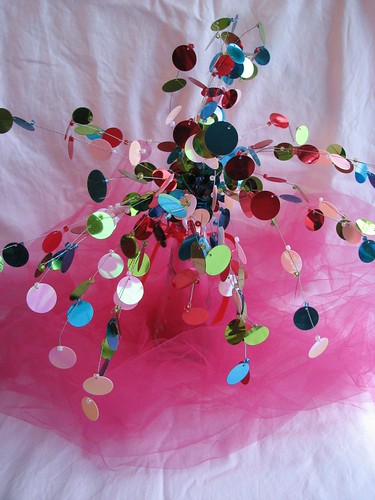
Here it's swathed in tulle.

You can see she put tulle in a vase (from Ikea--a great bargain) then stuffed those two things down in or maybe she wrapped them up first then put them in the vase. (I didn't ask.) She tied a ribbon around the vase and there you have it! It's a perfect decoration for just about any time of year. Use a different color tulle or ribbon to make it appropriate for Valentine's Day, Christmas, a party, etc.


Then, of course, she captured the whole thing with some great pictures. :)

Here it's swathed in tulle.

You can see she put tulle in a vase (from Ikea--a great bargain) then stuffed those two things down in or maybe she wrapped them up first then put them in the vase. (I didn't ask.) She tied a ribbon around the vase and there you have it! It's a perfect decoration for just about any time of year. Use a different color tulle or ribbon to make it appropriate for Valentine's Day, Christmas, a party, etc.


Then, of course, she captured the whole thing with some great pictures. :)
Amy's amazing photography
She put the camera on the tungsten setting (which I did not know existed, but what's new?) and was able to get some gorgeous pictures of a bluejay that was at one of our feeders. Having bird feeders in the winter has brought us many hours of enjoyment and learning. We can praise God for creativity that is awesomely detailed. We've all been able to take incredible photos of many of the birds. We don't necessarily have wonderful talent, although I'm not going to say we don't have any talent, we do have a good camera and some helpful birds to be our subjects. :)





If you click on any of the pictures it'll take you to my Flickr page.





If you click on any of the pictures it'll take you to my Flickr page.
Subscribe to:
Posts (Atom)




